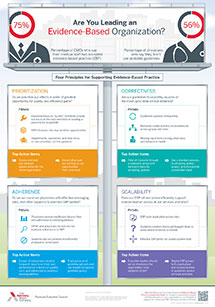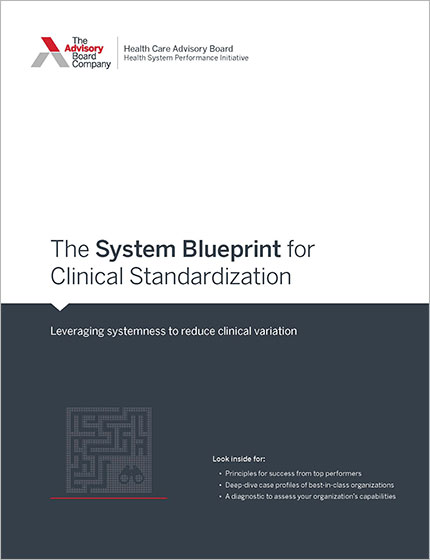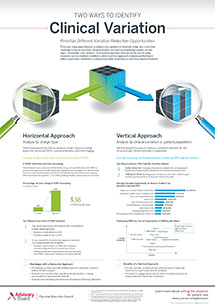Auto logout in seconds.
Continue LogoutBy Jackie Kimmell, Senior Analyst
As I mentioned in a previous explanation of the science behind four common health myths, it can be hard to distinguish myth from fact in the world of health.
Even for those of us who work in health care, it can be difficult to keep up with the stream of new scientific studies, understand contradictory evidence, and dispel wrong assumptions. Therefore, we've dug into three more common health myths to help you understand their origin and the scientific evidence behind them.
Read on to learn about the real science behind these myths and then learn what our researchers have found is the key to promoting evidence-based practices at your organization.
1. Sugar makes kids hyper.
This myth was likely born in 1973 when allergist Benjamin Feingold published his popular Feingold Diet, which suggested to parents that they should avoid food additives in their children's diets. Refined sugar in children's diets soon also fell under scrutiny.
It took only a few years for the public to jump from viewing refined sugar as unhealthy to it causing children to act hyper and misbehave.
However since then, an array of studies have refuted this often-believed myth. A 1995 meta-analysis of 23 studies in the Journal of the American Medical Association found no effect from sugar on the cognitive performance or behavior of children. Researchers did note, however, that they couldn't rule out that sugar has a small effect on a small subset of children.
Just as in adults, increased blood sugar in children might lead to an energy boost if a child is feeling lethargic because of low-blood sugar levels (known as hypoglycemia), but this boost would come only from returning them to a normal energy state. For children with normal blood sugar levels, eating sugar will just lead the child's body to convert those extra sugars to fat, not energy.
The reason the myth has persisted might actually be due to parents convincing themselves that it is true. One study showed that parents actually perceive their children as being more hyperactive after being told they had a sugary drink, even though their children were given nothing.
2. You need to take a daily multivitamin.
The number of Americans taking multivitamins decreased over the past decade—the 37% who reported taking them in 2000 had fallen to 31% in 2012—in part because the science supporting multivitamins has largely been inconclusive.
Catherine Price, a science journalist, has said there are 13 vitamins that scientists believe are associated with good health. Those vitamins can be gleaned from everyday food, but most Americans don't eat the recommended amounts of fruits and vegetables, so many consume their vitamins and minerals in a pill form instead.
“Others studies have found that multivitamins could, in fact, be harmful.”
But to date, there's been limited evidence that a daily multivitamin has a causal impact on long-term health. A meta-analysis conducted for the U.S. Preventative Services Task Force found that there was no clear evidence of dietary supplements impacting total mortality, cardiovascular disease, or cancer. Another study found no impact of multivitamins on cognitive decline, and another found no link to the risk of repeat cardiovascular events.
Others studies have found that multivitamins could, in fact, be harmful. One study of 38,000 women from age 50 to 60 found that daily multivitamin use was actually associated with a slightly (6%) increased risk of total mortality.
This is might be because, while vitamins seem intuitively appealing (if minerals and vitamins are good for you, taking them in a pill should be good for you too), the excess amounts often found in supplements can be too much for the body. For example, studies have shown that too much beta carotene and vitamin E can lead to cancer, and excess vitamin A can cause liver damage, coma, and mortality.
The fact that Americans spent $28 billion on dietary supplements in 2010 led an editorial in the Annals of Internal Medicine to declare: "Enough is enough. Stop wasting money on vitamin and mineral supplements."
However, for those at risk of deficiencies, multivitamins can be useful. Those with inflammatory bowel disease, celiac disease, or those who have had gastric bypass surgery may need a vitamin to meet their dietary needs.
3. You use only 10% of your brain.
The myth that we use 10% only of our brain is sometimes misattributed as having originated with Albert Einstein, although no record exists of him making such a claim. It could also possibly come from famous American psychologist William James, who liked to argue that humans were meeting only 10% of their full potential. When famous journalist and adventurer Lowell Thomas wrote the 1936 introduction to Dale Carnegie's How to Build Friends and Influence People, he apparently misunderstood James' aphorism and claimed James had said we use only 10% of our brain.
However, this claim has been soundly disproved three times over. First, advanced brain imaging—including PET scans, MRIs, and EEGs—have shown that almost all of the brain is engaged when undertaking any given task.
Second, the idea that we would only be using 10% of our mental capacity seems implausible given natural selection, as it is unlikely that we would have evolved to squander energy on a 90% useless organ—especially given how metabolically expensive brain tissue is to grow and run.
Finally, clinical neurology suggests that there's no area of the brain which can be destroyed, either due to a stroke or head trauma, which will not leave a patient with some sort of functional problem. If the myth was actually true, only 10% of brain damage would actually cause functional deficits.
How can you run an evidence-based organization?
It's easy to imagine that, as health care professionals, we're immune from these kinds of myths—that we base our practices solidly on evidence, and that we're willing to discard old ideas when they prove ill-supported. But the truth is that even when practice standards are available—and supported by credible evidence—they often aren't put into practice.
“Only 44% of physicians use available clinical guidelines and 72% of CMOs have trouble successfully promoting EBP with their physicians.”
Advisory Board surveys have found that only 44% of physicians use clinical guidelines when they're available. What's more, 72% of CMOs have trouble successfully promoting evidence-based practice (EBP) with their physicians.
EBP implementation can be hampered by a host of factors, such as physician frustration with the volume of clinical practice changes they must implement, outlier physicians who are outspoken in their critique of guidelines (and thus influence their peers), or physicians who feel they must accede to family demands instead of clinical guidelines.
We've discovered 27 tactics that organizations can use in promoting the uptake of EBP. Of these tactics, our survey found that most organizations are already using tactics which help them create guidelines. There appears to be few problems at most organizations in convening the appropriate stakeholders, clinical consensus groups, and resources to make solid, evidence-supported guidelines.
However, the least-used tactics were—perhaps unsurprisingly—those which promoted adherence to guidelines. Many CMOs and executives were not monitoring physicians who deviated from the guidelines and asking them why they did so.
Tracking guideline deviations was one of the most important tactics that made a difference on promoting the full adoption of EBP. Therefore, our researchers spoke with a variety of organizations to see who was successful in tracking these deviations and learned their best practices about how to get physicians to adhere to EBP.
Download our executive research briefing on how to advance evidence-based practice at your organization to see what organizations like Intermountain Healthcare, MultiCare Health and others have done to improve their EBP adherence.
Then, read our new research report on embedding care standards into frontline physician practice and learn seven tactics for how to deploy evidence-based standards organization-wide.
Don't miss out on the latest Advisory Board insights
Create your free account to access 1 resource, including the latest research and webinars.
Want access without creating an account?
You have 1 free members-only resource remaining this month.
1 free members-only resources remaining
1 free members-only resources remaining
You've reached your limit of free insights
Become a member to access all of Advisory Board's resources, events, and experts
Never miss out on the latest innovative health care content tailored to you.
Benefits include:
You've reached your limit of free insights
Become a member to access all of Advisory Board's resources, events, and experts
Never miss out on the latest innovative health care content tailored to you.
Benefits include:
This content is available through your Curated Research partnership with Advisory Board. Click on ‘view this resource’ to read the full piece
Email ask@advisory.com to learn more
Click on ‘Become a Member’ to learn about the benefits of a Full-Access partnership with Advisory Board
Never miss out on the latest innovative health care content tailored to you.
Benefits Include:
This is for members only. Learn more.
Click on ‘Become a Member’ to learn about the benefits of a Full-Access partnership with Advisory Board
Never miss out on the latest innovative health care content tailored to you.

 Get the blueprint for clinical standardization
Get the blueprint for clinical standardization
